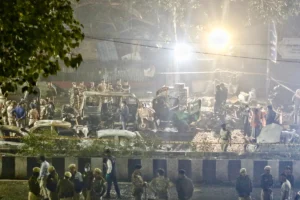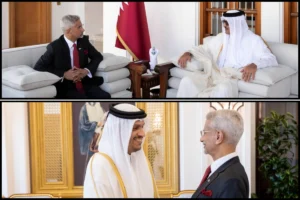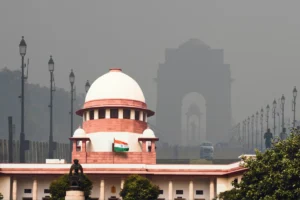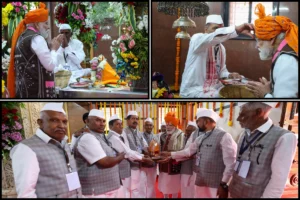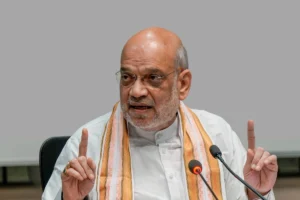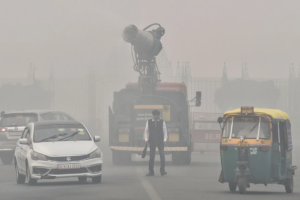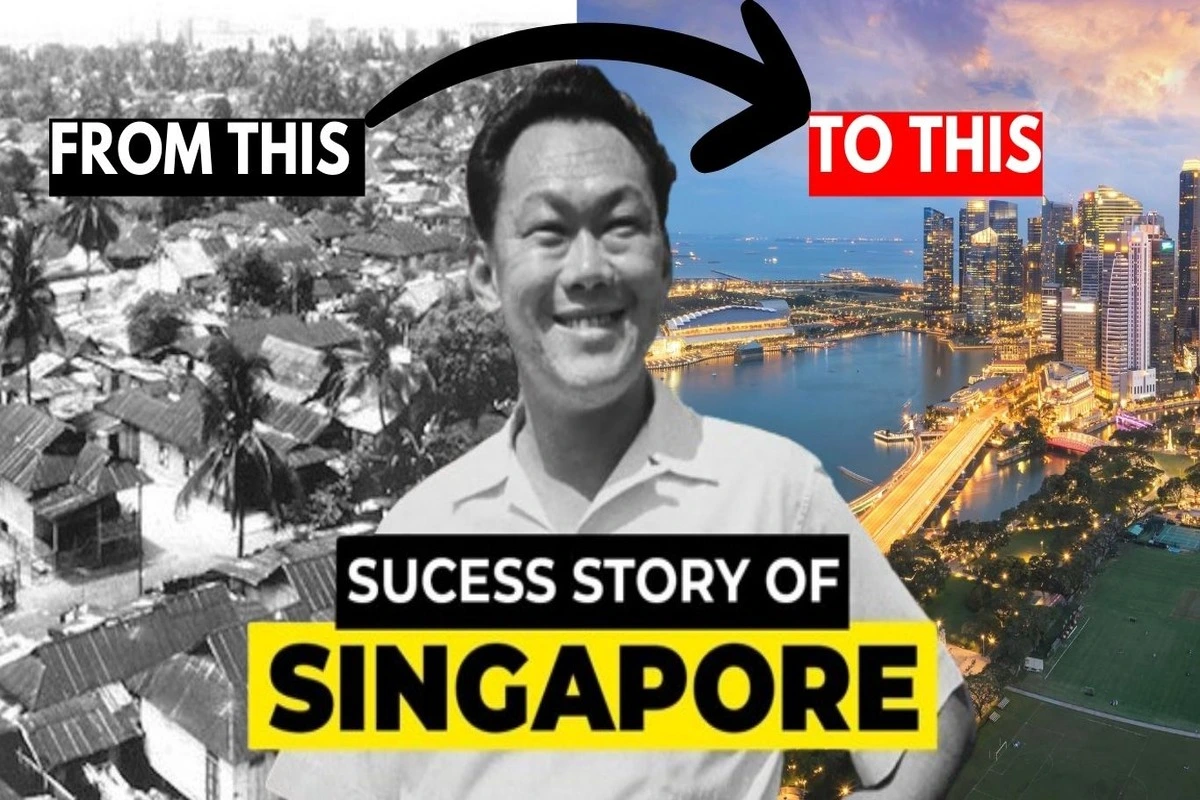
The Evolution of Singapore is one of the most fascinating case studies in the modern world history. Singapore is a small country but it ranks second in the world and first in Asia in terms of Per Capita GDP. But do you know that this country was not like this six decades ago? The unemployment rate was high, communal riots were erupting from time to time and the land of Singapore itself was one of the largest slum colonies in the world. And not just that, unlike other countries, Singapore had some severe disadvantages. They neither had a large population to depend on nor did they have vast lands. And most importantly, they did not have any natural resources like coal or oil. Rather for the sake of its own survival, it became a part of another country, Malaysia, That is, it was merged with Malaysia.
Why did Singapore secede from the federation just after two years of its merger with Malaysia? And became an independent sovereign country. After that, how did the country, surrounded by hunger and thirst, broken and devastated by the great war develop so much without natural resources? That it has become one of the richest countries in the world.
The question is —what exactly happened in those six decades that it transformed a small country like Singapore into the economic hub of the world? And most importantly as the citizens of the largest democracy in the world, what can we learn about the principle of building an incredible nation?
Singapore is a tiny country, So small, that it gets difficult to spot it on a map. The waterbody Strait of Johor separates Singapore and Malaysia. Singapore is half the size of Delhi, area wise. But on this small island, approximately six million people reside. The total area of Singapore is 734.3 square km. So the population density of Singapore in 2024 is 8,383.25 people per square kilometre, We consider India to be an overpopulated country. But for comparison, India’s population density 481 per square km. Singapore is 18 times more densely populated than India. Overall, it is the third most densely populated country in the world lagging behind Monaco and Macao.
Singapore is a diverse country. People belonging to various religions live harmoniously. There are people from five major religions here. Buddhist, Christians, Muslims, Hindus and Taoists. And there is also a small population of people from Jewish, Zorastrian, Jain and Sikh communities. The second largest group is the people who do not believe in religion, the Atheists. But apart from religion, Singapore is very diverse in terms of ethnicity too. The largest majority is of Chinese ethnic people at 74.5%, followed by Malays at 13.5% and Indians at 9%. Among the Indians, the largest populations are Tamils, Bengalis and Punjabis. And the remaining 3% are made of Eurasians and Arabs. While talking about the people, we should not forget about tribals Orang Laut. They are the original inhabitants living in Singapore for a very long time. Overall, “Unity in Diversity” is Singapore’s present day reality. But it was not the case always, going back into history, for a long time, the island of Singapore was used as a trading Island by the Malay, Thai, Indian, Arab, Japanese and Chinese traders. Throughout the history, it was occupied by an Indonesian ruler, the Portuguese, the Dutch through their Dutch East India Company Interestingly, Singapore’s name is itself derived from ‘Singa Pura’ (which means “Lion City”). The four highly developed countries in Asia are South Korea, Hong Kong, Taiwan and Singapore. That’s why Singapore is considered as one of the four Asian Tigers. Strikingly, the population density of these four countries is higher than India’s. But the GDP Per Capita of the four tigers is much higher than India’s. This might seem like a astonishing fact to some, because many people blame India’s huge population for the lack of development. As human resource is considered as a liability rather than an asset in India.
The story of Singapore begins in the early 19th century when the subcontinent was controlled by the British East India Company. They wanted to expand their empire. During this time, Malacca Strait was becoming very important for maritime trade and it was becoming very important for Britain to have a port of its own here. The East Asian region was largely under the control of the Dutch Empire at that time. Although Britain had commercial ports at Penang and Bencoolen, But British East India Company was looking for a port that was important from a strategic point of view. For this purpose, the company launched an expedition in 1819. During the same expedition, Stamford Rafael was the first British person to reach Singapore and he found this small island south of the Malaysia Peninsula most suitable for a port. The reason for this was that the water on the coast here was deep, there was also plenty of wood available for making ships. And the most importantly, Singapore was located just above Malacca Strait and the population was negligible. Britain acquired the right to build a port here through a treaty with the elder brother of the Sultan of Johor. Obviously, the Dutch had a strong objection to this agreement. After the arrival of Great Britain, population started to grow here slowly, so the concerns of the Dutch people started to increase. The Anglo- Dutch Treaty was signed in 1824 by the two colonial powers to divide the territory. According to this agreement, Britain gave the Bencoolen, an Indonesian territory to the Dutch Empire, while the Dutch Empire gave the Malacca territory to Britain. Whatever objections Dutch had about Singapore were withdrawn. After the First Opium War in China in 1839, There was an increase in commercial activity here. As trade increased, Singapore’s importance from a strategic point of view also increased. Then a large numbers of settlers from China and India started arriving here in the search of employment. By the end of the 19th century, Singapore’s population had reached two million.
Also read: EAM S. Jaishankar Engages With Political Leaders On Final Day Of Mauritius Visit
Fall of Singapore
During the early 1940s when the World War II was at its peak. As we know that World War II was fought between two groups of countries. The First group was the Axis Powers and the second was the Allied powers. The Axis alliance consisted of Japan, Germany and Italy. And they were in an agreement such that the Germans would capitalise on the Continental Europe, the Italians wanted domination over the Mediterranean Sea and the Japanese wanted domination over the East Asia and the Pacific. And in order to tackle this Axis alliance, there was another group of country called the Allied Powers consisted of Great Britain, Soviet Union and the United States.
Singapore in 1930 had been a British colony for over hundred years and the most valuable, perhaps, the only valuable asset they possessed was its location, because Singapore was at the heart of trade route that connected Asia and Europe. Which is why, Singapore became the crown colony of the British Empire. And while the island became extremely prosperous under the British Raj. When the Second World War broke out in 1939, the island was in a catastrophe.
Devastating Impact of World War II on Singapore
During this time, two major events happened. On 7th December 1941, the infamous act of Pearl Harbour happened and this is where the military unit of Japan attacked US navel base. And this was clearly an act of war. And secondly during the same time the Japanese troops were sweeping through Asia and they were very keen on capturing Singapore. But as far as the citizens of Singapore is concerned, they thought since the British Raj was so huge, they would very easily be able to protect the island from the Japanese. But Singapore came under the control of Japan and it was Japan’s greatest victory in World War II. Wherein less than 10,000 Japanese troops captured the island of Singapore and took 16,000 British Soldiers, 14,000 Australian Soldiers and 32,000 Indian Soldiers as Prisoners of War. And what followed next is regarded as one of the most horrific times in the history of Singapore. The Japanese troops carried out a series of massacres on all the prisoners including the innocent civilians. Thousands of people were killed brutally and things were so distressful that women were raped and shipped under tag of “Military Equipments” to various parts of the world. And most of these women were aged between 14 to18 years. And in the name of eliminating anti-Japanese people. The Japanese army killed around 50,000 people in less than two months under something called the Sook Ching Operation. This was the horrific state of Singapore for the next three years until 1945.
Another catastrophic event happened on 6th and 9th of August 1945, wherein the US military responded to Pearl Harbour by dropping a nuclear bomb in Hiroshima and Nagasaki respectively. And by this time, the German attack had fallen, Hitler was dead and within a month Italy was about to surrender. So, the Japanese had no other option but to retreat from Singapore and the British Raj came back to Singapore on 12th September 1945, that is ten days after the World War II ended. But this time, when the Britishers came back, Singapore was no longer the same crown colony that the Britishers lost to Japanese because the island was completely left in ruins. Much of the infrastructure had been destroyed, electricity and water supply lines were broken, many of the telephone services were non-functional and most importantly the harbour facilities at the port of Singapore had been completely ravaged. And because of this, the economy of Singapore was in complete ruins which eventually resulted into massive shortages of food. The condition of Singapore was so bad that even rice was considered to be a luxury. And when the people of Singapore witnessed these horrifying conditions, they lost faith in the British government.
The feelings of Nationalism begin to rise
As a result of which the nationalist movement began to spark all across Asia. This is where the historic process of decolonisation happened, wherein Britishers began packing their bags as business was no longer viable in Asia. This is the reason we witness the effect of WW II, that is, after 1945 onwards most of the Asian countries began to get their independence from the Britishers ( Jordon-1946, India and Pakistan in 1947, Burma- 1948, Ceylon (Old name of Sri Lanka)- 1948, Israel- 1948, Malaysia -1957, Kuwait- 1961).
In the case of Singapore, instead of leaving the country straight away , they let the elections be held under the British rule itself. ( First General Election held in 1959). And this is where the hero of Singapore enters. A young 31 year old lawyer named Lee Kuan Yew along with four other people founded a party called the People’s Action Party (PAP) which rose to power in British Singapore. Lee Kuan Yew, the Secretary General of People’s Action Party became the first Prime Minister of Singapore. Little did they know, back then, that this party will go on to redefine the destiny of Singapore and make it an iconic case study for the world to learn from.
Singapore had very less resources of their own and they literally had no direction on how to proceed ahead. And this is when they saw a new ray of hope in the form of Malaysia. Malaysia back then was a much bigger country as compared to Singapore. They had many more resources, they still have many more resources. And Singapore badly needed their help. Therefore, for its survival, Singapore wanted to merge with the Malaysian Federation, After a referendum in Singapore and a long period of negotiations Singapore finally became a part of the Malaysian Federation in 1963 under the Malaysia Agreement.
In the referendum, an overwhelming majority (70%) of the Singaporeans had chosen merger. According to the terms of an agreement, Singapore was obliged to give 40% of its revenues to the government of Malaysia. While Singapore and Malaysia were to complete steps to establish a common market within a period of 12 years. It was further decided that matters of defence, foreign affairs and external security of Singapore would remain under control of Malaysian government. While all the internal affairs will be controlled by the local government of Singapore and Singapore will be given 15 seats in the federal Parliament of Malaysia. The merger of Singapore and Malaysia in 1963 proved to be very short-lived. Just two years later, Malaysia seceded Singapore from the federation, that is, Singapore was now an Independent country.
Also read: Tragic Attacks In Gaza Result In Heavy Casualties, 40 Palestinians Killed
Why did Malaysia separate Singapore from the Federation despite the unwillingness of Singapore? There are two main reasons for this
The First reason is political. At that time, Lee Kuan Yew’s People’s Action Party (PAP) was the biggest political force in Singapore, While the United Malays National Organisation (UMNO) was the dominant party in the rest of Malaysia. In addition to the Malays, there was also a large number of Chinese throughout the Malaysian Federation. More than 70 percent of the population of Singapore consisted of Chinese settlers and most of the economy was under their control. UMNO was an anti- communist party and did not want Chinese influence to grow here. UMNO believed that the Malay people should have the right to greater representation in politics, jobs and other sectors, because they are locals and Malaysia is their country and Singapore is part of Malaysia. On the Contrary, the People’s Action Party, which was majority party in Singapore was of the opinion that no single ethnic group should get any special rights. This disagreement between the two parties also led to a racial riots in Singapore in which many people had to lose their lives.
Second reason of Singapore being separated from Malaysia was economic. As stipulated in the Singapore-Malaysia Merger Agreement, Singapore will give 40% of its revenues to the central government of Malaysia. But later, the Malaysian government was also demanding Singapore to increase their percentage, so as to establish a common market which was obviously quite difficult for Singapore. The ongoing political rivalry between the two parties was not ending and the threats of ethnic riots were increasing. Therefore, the PM of Malaysia decided that the only solution to this problem was to separate Singapore from the Federation and finally on 9th August 1965, Malaysia separated Singapore from the federation. And So, Singapore became an independent sovereign country unwillingly. After Singapore seceded from the federation of Malaysia in 1965, Once again, this small, economically depressed country was at the mercy of fate. Singapore had no natural resources to stand on its own feet. Even the food and drink items used to come from other countries.
And this further led to an economic disaster again. For more than 100 years, the Singapore economy was intertwined with Malaya. Industrial commodities like rubber and tin were produced in the Malayan mainland. And then they would transport it to Singapore to be traded all around the world. But within a fortnight, all of Singapore’s warehouses were left empty. Again, People lost jobs; again there were communal violence, again the economy was in trouble. Now they had no industries, very few factories and to make matters worse, their biggest employer, that is the British Army was planning to leave the country suddenly and completely. This was the very pathetic condition of the Singapore in 1965 particularly after Malaysia seceded Singapore from the federation.
The Hero of Singapore and the challenges after becoming an independent sovereign country.
The incredible leader or hero of Singapore that is Lee Kuan Yew whose strategy led to the path of incredible development in a short span of 35 years. The first thing he did was to identify the risk points and design a strategic solution for each one of these high risk points. And before getting into the act, Lee Kuan Yew spoke to the British authorities and convinced them to stay till 1975. Because had the Britishers left immediately, the island would have been left in ruins, thankfully the Britishers agreed and that is how the countdown started for the people of Singapore. And Lee Kuan Yew had just ten years in hand to turn the situation around for Singapore
The First thing he did was, he started to build an army from scratch as during the same time Indonesia was witnessing a military coup because of which the government in Indonesia had fallen. And if the Singapore did not have an army of their own either a country like Indonesia could have invaded them or that could have been an insider threat. The Britishers also employed a lot people which is why at least 30 thousands jobs had to be created before the Britishers left.
Lee Kuan Yew sought the help from Israel in order to fix the issue of army and came up with an idea of National Service just like an Israel and made it mandatory for all men above the age of 18 years by something called the National Service Act in 1967. This gave the Island two major benefits the first one an army of their own people but each of these recruits was taught in school that the greatest threat to the country is not the invasion by an outsider but the conflict within the insiders. And the military practices started to lay the foundations both for the army and the unity of the country. And even today the value of unity is ingrained in the lessons taught in schools and colleges of Singapore. While in India, in the name of Nationalism, we have got pseudo-liberals and radicals popping up and in Twitters, we often see that both of these groups engaging in texting wars which results into nothing but futile debates. But the underlying problem over here is these cyber riots won’t take long before they turn into physical riots. So, our generation needs to be taught the value of unity and the fact that there is a thin line between pseudo-liberalism, nationalism and radicalism.
Second, There was no industries or major factories, they had to build the infrastructure so that they could build businesses of their own or invite foreign investment into the island. There was a challenge for creating enough jobs. And this is where Lee Kuan Yew used perspective about learning from other countries came in very handy. Just like today we have got software companies that are creating jobs all across the world. The era of the 1940s and 50s was all about the textiles industry and this is where countries like Hong Kong and South Korea were also undergoing a similar situation like that of Singapore in the 1960s, wherein they had a poor economy and they did not have enough jobs, So they opened up their country and invited textile companies from all across the world to create jobs because they could provide them with the cheapest labour rates in the world. And Lee Kuan Yew understood the potential of this move way back in 1960s itself. Just like the textile industry was prospering in the 1940s and 50s, the electronics industries was prospering in the 1960s. So way back in 1960s itself just like Hong Kong, the government of Singapore enacted new laws which would lower the labour costs and gave out amazing incentives to companies by lowering the taxes on imports and exports duties. For Example if a company wants to move from one country to other country for manufacturing, the only reasons for their hesitancies is the heavy investment that they have to make for land and infrastructure. So to make it easy the government would give them land at a very heavy discount and the import taxes on machine and equipments would be lowered to a rock bottom level. This is very similar to that of razor blade model wherein the land and import duties are like razors which are given away at a dirt cheap cost, So that the government can create a recurring income out of the taxes on the profits of the company and the salaries of the employees. How incredible and futuristic this vision was, While Singapore opened up to the world way early in the 1960s itself, China opened up to the world 10 years later, post 1978. And India opened up to the world more than two decades later in 1991. When we were at the brink of an economic crisis.
In case of Singapore this futuristic move created thousands of jobs for the people of the island. And when things were going very well, a shocking news came in, wherein the Britishers announced that they were about to leave the country four years early in 1971 itself. And this meant that 30,000 people will be left jobless within that year itself. But by 1971 itself, Singapore had created so many jobs that not a single one of those people were left jobless. Not a single piece of land was left unoccupied, not a single building was left unutilised. And every single resource was turned into an economic asset. This is how Singapore evaded the second risk and that is loss of jobs due to the early departure of the Britishers. And when this happened the world knew that Singapore is not just an ordinary island but an extraordinary nation in the making.
Also read: Bus Accident In Peru Claims 26 Lives
Visions of Lee Kuan Yew for his country
And the third pillar and that is Strategic Infrastructural Investment. Over the period 1963 to 1975, Singapore received 14 loans from the World Bank. The first ten were exclusively in the infrastructure sectors and included water interconnection, port expansion, sewage, power and telecommunications. And two of the most mind-bowing projects are the Jurong Port and the Jurong Town Corporation (JTC). Both these projects were implemented such that Singapore could leverage the only valuable assets they had and that is the strategic location for trade. And it was the well visioned investment because Singapore invested 14 million US dollars to build the Jurong Port and today the Jurong Port generates a revenue of more than 155 million US dollars every single year.
Meanwhile, the JTC was responsible for the major infrastructure projects like the clean up of the Singapore river which was once a dumping ground by the way, full of filth. But today it was turned into one of the most beautiful and the most attractive tourist spot in the island. The JTC was also responsible for the reclamation of land and many such major construction projects on the island. The same Jurong Town Corporation that was initiated during the old days of Singapore, today it has become a major contributor to the economy and in 2020 alone. It has generated a revenue of around 2.2 billion US dollars. This is what happens when the government knows how to do business.
The most incredible infrastructural projects of Singapore and that is the fixing of housing crisis. As we know that Singapore was once one of the largest slum colonies in the world. And these slum colonies again brought three potential threats to the country. First, the slum colonies occupied a large area which could have been used for more productive ventures like industries and hotels. Second, these slum colonies were in a very unhygienic condition and could have resulted into disease outbreak in no time. And third, these colonies were formed in clusters and led to communal segregation. For instance , there was a cluster wherein only Tamilians lived or the other cluster wherein only the Chinese lived. Now on the outside this might not look like a big deal. But communal segregation is one of the biggest threats to the society because communal segregation is what leads to communal violence. Look at any horrific riot that has happened in India or the rest of the world and we will find that they are directly or indirectly associated with communal segregation. This is the reason why Lee Kuan Yew made it a priority to not just build houses but to also make sure that people of every community lived together without being segregated. And this is where the role of HDB, that is, Housing Development Board came in.
And they executed this using three wonderful strategies. First, in order to make houses affordable they made it mandatory for the people of Singapore below the age of 55 years old to save 20% of their income into a Social saving funds and this is what was called as the Central Provident Fund. And the employers were also asked to contribute 17% to this fund. And the money could be spent only on specific essentials or on housing. And this who could not afford it, apartments were given at subsidised rates on rent so that when these people had enough money in their savings account they could take a low interest loan, eventually, buy the house itself.
Second, to prevent these societies from deteriorating into a modern slum, the HDB ensured high quality maintenance and made hygiene a priority because of which the public housing of Singapore looks like an elite township.
And third and most importantly the beauty of their town planning is that they introduced something called the Ethnic Integration Policy in 1989. By which every building has a specific quota for every ethnic group depending on their population ration. For instance, the buildings block will be given possession as the percentage of the population of various ethnicity. And because of this wonderful move the Chinese, the Malays and the Tamilians and all other minorities lived in the same neighbourhood. And most importantly, they had equal access both the housing facilities like parks and government facilities like metro and railways. And this avoided clusters to a large extent and minimised one of the biggest’s threats that haunted Singapore for decades and that is communal violence. And there are very very less clusters because of which all the communities in the island live peacefully together.
As result of which, the best part is politicians have not been able to use communal disputes to create a vote bank. Today, Singapore is such an amazing place to do business that people brag about how you can open a company in Singapore in less than three hours. And the medical facilities are so good that the leaders of other nations take a special trip to Singapore so that they can get admitted into a hospital and get themselves treated. These are the high standards that Lee Kuan Yew set for the people of Singapore and in 35 years of his government, the per capita GDP of the country jump from around 500 US dollars in 1965 by a staggering 2800% to US dollars to 14,500 US dollars by 1991. The Gross Domestic Product per capita in Singapore was last recorded at 65422.46 US dollars in 2023.
Every politician, every leader and every citizen needs to understand the difference between mindless socialism, conscious capitalism, and evil capitalism. Mindless Socialism is when the government gives out unnecessary subsidies, not for the progress of the people but to create a vote bank. The other extreme of the same is evil capitalism wherein the government and the companies will try to make money even if that means charging for cancer medicines and making money out of the disease caused to the citizens. And far away from both these concepts is where we have conscious capitalism wherein the government puts restriction on the citizens and spends very penny of the public fund to generate a return on investment and runs a country like an organisation which need to channelise its profits towards the welfare of its citizens. And just like Lee Kuan Yew learned from Hong Kong and South Korea, it is important that the citizens and politicians learn from the success and failures of countries, so that we can become constructive critics of these policies and politicians can frame policies based on the learnings from these countries.This is the crucial steps that we all need to take to become informed citizens of this democracy.
If a country wants to be truly developed, education is among the first things that needs to be focussed on. Singapore did this. All Singapore citizens born after 1st January 1996, and living in Singapore must attend a national primary school unless an exemption is granted. High quality Pubic Education, the government runs excellent schools and colleges. The infrastructure of the schools is very impressive and Public education is valuable at normal fees. It is almost free.
Singapore is the most expensive city if you want to buy a car. There is a heavy tax on buying a car. Singapore is already an incredibly expensive place to own a car. Drivers need to buy a special certificate from the government — which can cost as much as 50,000 Singaporean dollars (37,000 US dollars ), before they can hit the road. The certificates last 10 years, and authorities hold monthly auctions for them.
On the other hand hand, public transportation like the buses and the metro, Singapore has one of the least expensive public transport in the world. Singapore’s public transport system among the best in the world. One of the world’s greatest and most affordable public transportation networks is found in Singapore. It is affordable for people. In addition to being one of the cleanest and safest.
In Singapore, public as well as private health care is quite inexpensive. Under the Ministry of Health, government hospitals have been equipped with thousands of beds. And they have the innovative Medi Safe, Media Shield, and Media Fund system in the healthcare sector
In 1992, chewing gum was banned in Singapore. No compromise in cleanliness. Apart from this, major laws were enacted to levy heavy fines. For spitting, littering, smoking, in the first offence would be fine 1,000 Singaporean dollars, in the second offence 2,000 Singaporean dollars and the third offence would attract a fine 5,000 Singaporean dollars.
By hearing all these things it seems that the government is offering cheap things. Education, Healthcare, Public Transportation and Housing. People are given these at a low cost to make these affordable. But where does the government get the money to do so? Does the government charge a high tax rate from the people? The way it is in several European Countries where the tax rate crosses 50% even. Countries like Sweden, Finland, Denmark, and Austria. But no, the income tax rates in Singapore are quite low between 2% to 24%. So how can the government manage to bring in the fund? The primary principles of Singapore’s government, they focus a lot on sustainability and fiscal deficit.
In terms of ease of doing business, Singapore is ranked number two in the world following New Zealand. To do so, a major precondition was to eliminate corruption in the country. Corruption would only hinder businesses.Today, out of 180 countries, Singapore is the 4th least corrupt country in the world.
In 1972, the Singaporean government launched an initiative of Tree Planting Day. A specific day on which all residents came together to plant trees. This initiative was so successful that within 10 years, the number of trees planted was the same as the number of people living in Singapore. Within 10 years, they had cleaned their river. And today, the best indoor gardens are found in Singapore. Singapore’s greenery has become a tourist attraction now.
What was Lee Kuan Yew’s trick to end corruption?
First, he raised the salaries of government employees as well as the salaries of politicians and ministers. They are paid such high salaries that you won’t believe it. The current salary of Prime Minster of Singapore Lee Hsien Loong is the son of Lee Kuan Yew. He is the highest paid Prime Minister in the world. He is paid a salary of 1.61 million US dollars. Carrie lam – Chief Executive Hong Kong (CEO) – 6,72,000 USD, Joe Biden- The US President -4,00,000 USD. Angela Merkel -The Chancellor of Germany – 3,69,727 USD.
It is the same for government employees. They are paid good salaries. The logic for this is if you pay good salaries to government employees and minsters. They cannot be encouraged to engage in corruption. Since they already receive handsome salary. On the top of it, the salaries have a performance-related component as well. Their performance is rewarded by this.
Third, if a minister is so greedy as to engage in corruption despite the high salary, they will be given heavy punishment, fine upto 1,00,000 USD and imprisonment upto five years. In 1960, The People’s Action Party (PAP) introduced the Prevention Corruption Act. (PCA). Their Corrupt Practices Investigation Bureau was given more powers. It was made Independent. Basically, it is an agency that investigates corruption. It is given Operational Autonomy. Even though it works under the Prime Minister’ office, the Prime Minister cannot interfere in its work. No political leader can interfere in it. This autonomy is very important since if any politician engages in corruption, this agency can take action against it as well.
And Singapore went from being a slum colony to becoming a land full of high-rises and Skyscrapers. And the same Singapore which was once sinking in poverty has now become a super prosperous financial and manufacturing hub of the world. And most importantly. Singapore went from being a vulnerable piece of island to becoming one of the richest and one of the most powerful nations in the world.
To read more such news, download Bharat Express news apps









